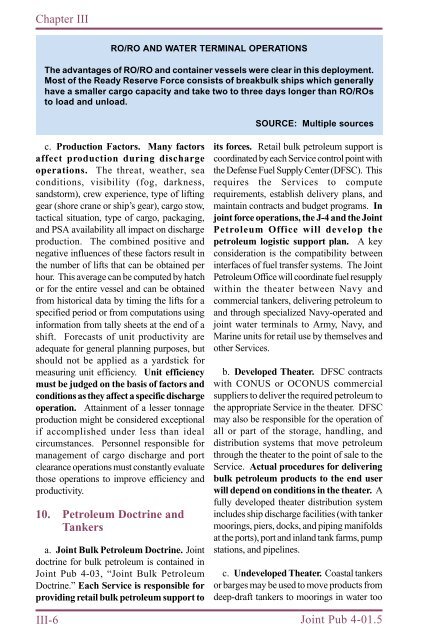JP 4-01.5 JTTP for Water Terminal Operations - BITS
JP 4-01.5 JTTP for Water Terminal Operations - BITS
JP 4-01.5 JTTP for Water Terminal Operations - BITS
Create successful ePaper yourself
Turn your PDF publications into a flip-book with our unique Google optimized e-Paper software.
Chapter III<br />
III-6<br />
RO/RO AND WATER TERMINAL OPERATIONS<br />
The advantages of RO/RO and container vessels were clear in this deployment.<br />
Most of the Ready Reserve Force consists of breakbulk ships which generally<br />
have a smaller cargo capacity and take two to three days longer than RO/ROs<br />
to load and unload.<br />
c. Production Factors. Many factors<br />
affect production during discharge<br />
operations. The threat, weather, sea<br />
conditions, visibility (fog, darkness,<br />
sandstorm), crew experience, type of lifting<br />
gear (shore crane or ship’s gear), cargo stow,<br />
tactical situation, type of cargo, packaging,<br />
and PSA availability all impact on discharge<br />
production. The combined positive and<br />
negative influences of these factors result in<br />
the number of lifts that can be obtained per<br />
hour. This average can be computed by hatch<br />
or <strong>for</strong> the entire vessel and can be obtained<br />
from historical data by timing the lifts <strong>for</strong> a<br />
specified period or from computations using<br />
in<strong>for</strong>mation from tally sheets at the end of a<br />
shift. Forecasts of unit productivity are<br />
adequate <strong>for</strong> general planning purposes, but<br />
should not be applied as a yardstick <strong>for</strong><br />
measuring unit efficiency. Unit efficiency<br />
must be judged on the basis of factors and<br />
conditions as they affect a specific discharge<br />
operation. Attainment of a lesser tonnage<br />
production might be considered exceptional<br />
if accomplished under less than ideal<br />
circumstances. Personnel responsible <strong>for</strong><br />
management of cargo discharge and port<br />
clearance operations must constantly evaluate<br />
those operations to improve efficiency and<br />
productivity.<br />
10. Petroleum Doctrine and<br />
Tankers<br />
a. Joint Bulk Petroleum Doctrine. Joint<br />
doctrine <strong>for</strong> bulk petroleum is contained in<br />
Joint Pub 4-03, “Joint Bulk Petroleum<br />
Doctrine.” Each Service is responsible <strong>for</strong><br />
providing retail bulk petroleum support to<br />
SOURCE: Multiple sources<br />
its <strong>for</strong>ces. Retail bulk petroleum support is<br />
coordinated by each Service control point with<br />
the Defense Fuel Supply Center (DFSC). This<br />
requires the Services to compute<br />
requirements, establish delivery plans, and<br />
maintain contracts and budget programs. In<br />
joint <strong>for</strong>ce operations, the J-4 and the Joint<br />
Petroleum Office will develop the<br />
petroleum logistic support plan. A key<br />
consideration is the compatibility between<br />
interfaces of fuel transfer systems. The Joint<br />
Petroleum Office will coordinate fuel resupply<br />
within the theater between Navy and<br />
commercial tankers, delivering petroleum to<br />
and through specialized Navy-operated and<br />
joint water terminals to Army, Navy, and<br />
Marine units <strong>for</strong> retail use by themselves and<br />
other Services.<br />
b. Developed Theater. DFSC contracts<br />
with CONUS or OCONUS commercial<br />
suppliers to deliver the required petroleum to<br />
the appropriate Service in the theater. DFSC<br />
may also be responsible <strong>for</strong> the operation of<br />
all or part of the storage, handling, and<br />
distribution systems that move petroleum<br />
through the theater to the point of sale to the<br />
Service. Actual procedures <strong>for</strong> delivering<br />
bulk petroleum products to the end user<br />
will depend on conditions in the theater. A<br />
fully developed theater distribution system<br />
includes ship discharge facilities (with tanker<br />
moorings, piers, docks, and piping manifolds<br />
at the ports), port and inland tank farms, pump<br />
stations, and pipelines.<br />
c. Undeveloped Theater. Coastal tankers<br />
or barges may be used to move products from<br />
deep-draft tankers to moorings in water too<br />
Joint Pub 4-<strong>01.5</strong>
















